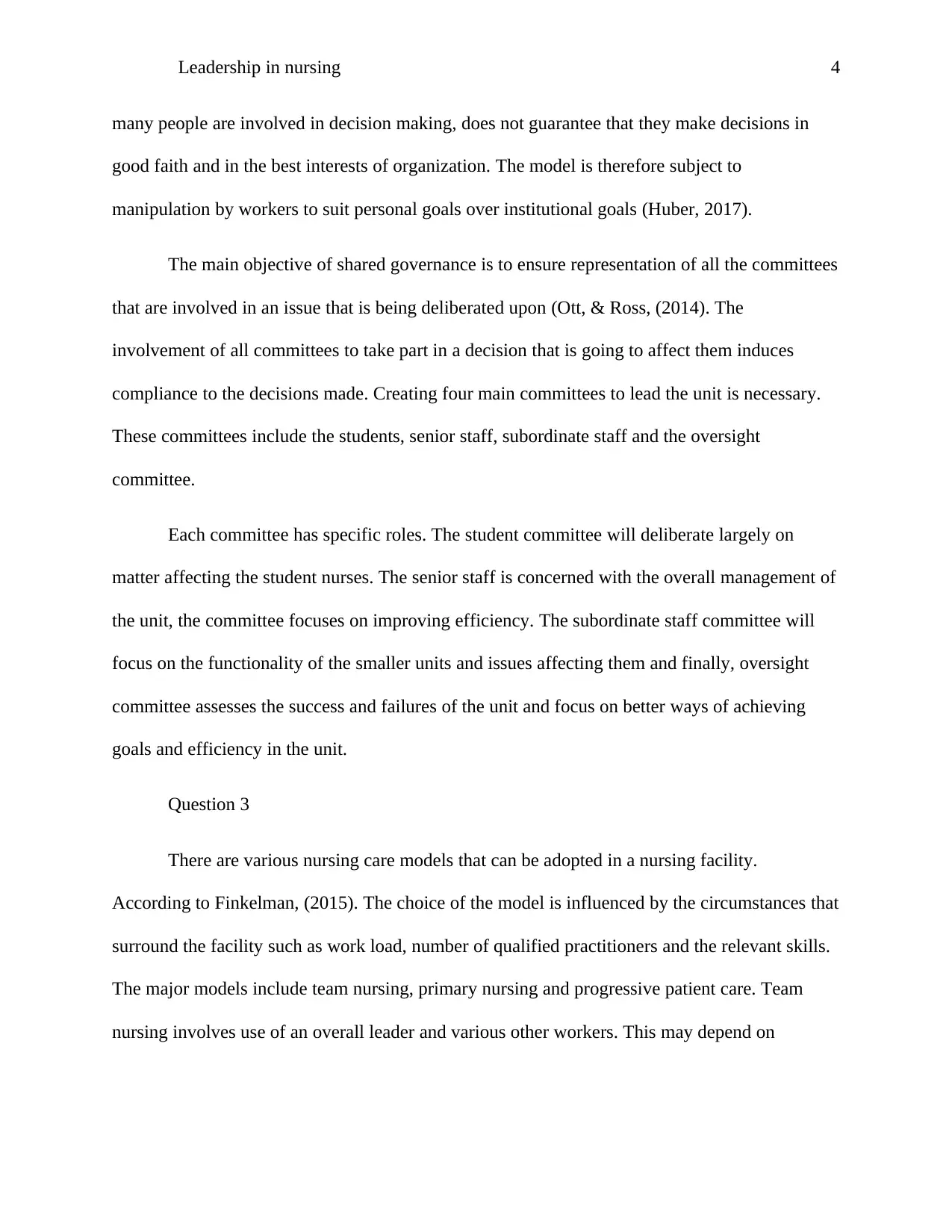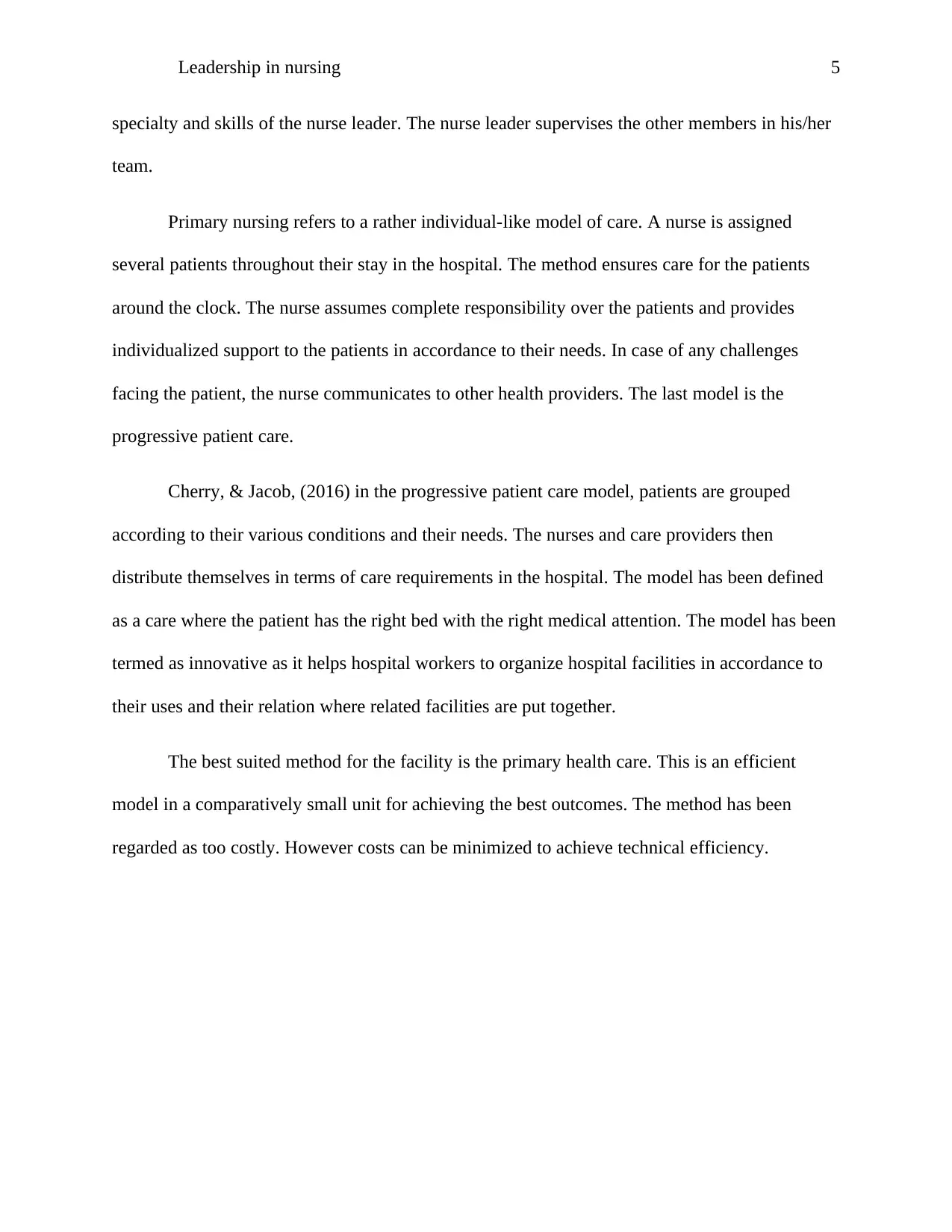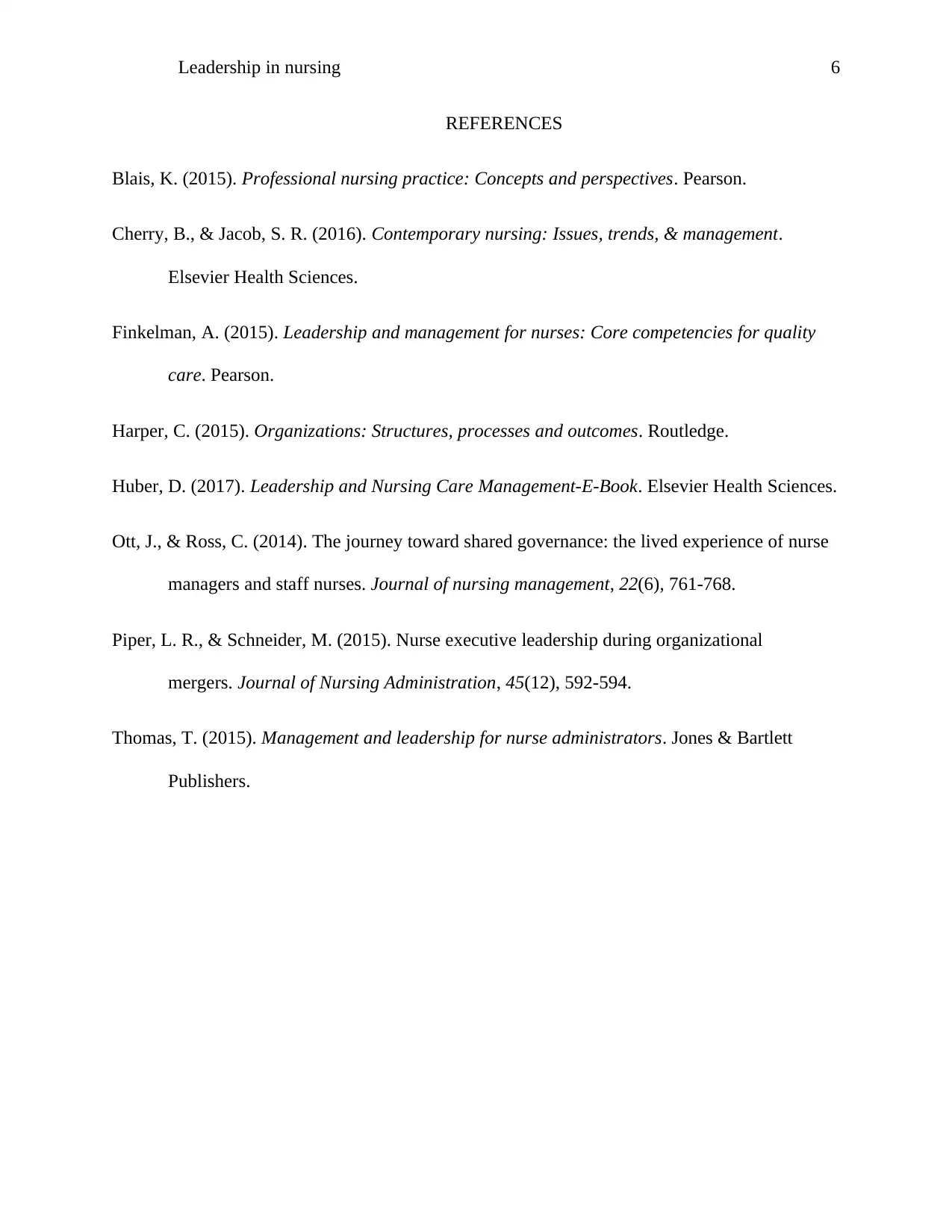Leadership in Nursing: Centralized vs Decentralized Management, Shared Governance, and Nursing Care Models
VerifiedAdded on 2023/06/13
|6
|1408
|336
AI Summary
This article discusses the differences between centralized and decentralized management, the advantages and disadvantages of shared governance, and the different nursing care models. The author argues in favor of a decentralized management structure for a small unit, and recommends the primary nursing care model for nursing facilities. References are provided for further reading.
Contribute Materials
Your contribution can guide someone’s learning journey. Share your
documents today.

Running head; Leadership in nursing 1
Leadership in Nursing
Student’s name
Institutional affiliation
Leadership in Nursing
Student’s name
Institutional affiliation
Secure Best Marks with AI Grader
Need help grading? Try our AI Grader for instant feedback on your assignments.

Leadership in nursing 2
Question 1
Centralization and decentralization are the two main structures of an organization. An
organization can adopt either structure in the running of its activities to achieve certain desired
outcomes. In a centralized management, Harper, (2015) the power to make decisions is
concentrated at the top management. The decisions made at the top are communicated to other
levels of workers in a rather vertical system. However, in a decentralized management, the
power to make decisions is delegated to other levels of staff. The decisions made at the
decentralized organization reflects team participation and delegation.
According to Piper, & Schneider, (2015) one major difference between the centralized
and the decentralized organization is the structure and authority. In a centralized system, few
people make decisions and pass the decisions to the other workers at lower levels of
management. The decision making in the centralized organization is comparatively slow but it
reflects higher levels of coordination and leadership. The centralized structure is largely
practiced in small organizations. On the other hand, in a decentralized system, the authority to
make decisions is delegated to different levels of management across the management structure.
The decision making is relatively faster and there is collective responsibility and sharing of
burden. This system is mainly practiced in larger organizations.
In my unit, I would prefer the decentralized organization despite the fact that it is a small
unit with only 25 medical beds. The main reason is that the decentralized system unlike the
centralized system empowers the employees to propel the organization forward by having the
organization’s objectives and goals when carrying out activities and discharging duties. Again,
when people are empowered to make decisions, they are not only bound to implement these
decisions but they are also obliged to ensure that they work for the common good of the
Question 1
Centralization and decentralization are the two main structures of an organization. An
organization can adopt either structure in the running of its activities to achieve certain desired
outcomes. In a centralized management, Harper, (2015) the power to make decisions is
concentrated at the top management. The decisions made at the top are communicated to other
levels of workers in a rather vertical system. However, in a decentralized management, the
power to make decisions is delegated to other levels of staff. The decisions made at the
decentralized organization reflects team participation and delegation.
According to Piper, & Schneider, (2015) one major difference between the centralized
and the decentralized organization is the structure and authority. In a centralized system, few
people make decisions and pass the decisions to the other workers at lower levels of
management. The decision making in the centralized organization is comparatively slow but it
reflects higher levels of coordination and leadership. The centralized structure is largely
practiced in small organizations. On the other hand, in a decentralized system, the authority to
make decisions is delegated to different levels of management across the management structure.
The decision making is relatively faster and there is collective responsibility and sharing of
burden. This system is mainly practiced in larger organizations.
In my unit, I would prefer the decentralized organization despite the fact that it is a small
unit with only 25 medical beds. The main reason is that the decentralized system unlike the
centralized system empowers the employees to propel the organization forward by having the
organization’s objectives and goals when carrying out activities and discharging duties. Again,
when people are empowered to make decisions, they are not only bound to implement these
decisions but they are also obliged to ensure that they work for the common good of the

Leadership in nursing 3
organization. Decision making is also considerably faster in a decentralized system which
increases performance of the employees argues Thomas, (2015). It is therefore in my view that a
decentralized system would be more effective as opposed to a centralized one.
Question 2
Shared governance refers to collaboration with staff in decision making to achieve
desired outcomes such as high quality care, professionalism and competence and developing a
holistic approach to care. Shared governance focuses on six major aspects which include;
defining the confinements of decision making, collaborative efforts between staff and workers,
meeting formally and more often, agendas to be discussed are planned and disseminated prior to
the meeting, relationship between members and staff is guided by well stipulated and spelled out
principles and finally, there is continued strive for consensus in decision making which reflects
shared decision making.
Blais, (2015) holds that shared governance has several advantages that makes it an
effective and efficient model of governance. Shared governance empowers employees as they
feel an integral part of the organization. The model encourages accountability from employees as
it has a natural system of ensuring checks and balances where every employee has a stake in
decision making and implementation process. Shared governance also encourages
communication and team work among employees which helps to improve quality and
consistency. Better decisions are arrived at due to involvement of a larger team.
The disadvantages of shared governance are; for one, it slows decision making as the
workers struggle to achieve a consensus decision. The time taken to plan and organize various
activities also slows the progress of the organization. Another disadvantage is that the fact that
organization. Decision making is also considerably faster in a decentralized system which
increases performance of the employees argues Thomas, (2015). It is therefore in my view that a
decentralized system would be more effective as opposed to a centralized one.
Question 2
Shared governance refers to collaboration with staff in decision making to achieve
desired outcomes such as high quality care, professionalism and competence and developing a
holistic approach to care. Shared governance focuses on six major aspects which include;
defining the confinements of decision making, collaborative efforts between staff and workers,
meeting formally and more often, agendas to be discussed are planned and disseminated prior to
the meeting, relationship between members and staff is guided by well stipulated and spelled out
principles and finally, there is continued strive for consensus in decision making which reflects
shared decision making.
Blais, (2015) holds that shared governance has several advantages that makes it an
effective and efficient model of governance. Shared governance empowers employees as they
feel an integral part of the organization. The model encourages accountability from employees as
it has a natural system of ensuring checks and balances where every employee has a stake in
decision making and implementation process. Shared governance also encourages
communication and team work among employees which helps to improve quality and
consistency. Better decisions are arrived at due to involvement of a larger team.
The disadvantages of shared governance are; for one, it slows decision making as the
workers struggle to achieve a consensus decision. The time taken to plan and organize various
activities also slows the progress of the organization. Another disadvantage is that the fact that

Leadership in nursing 4
many people are involved in decision making, does not guarantee that they make decisions in
good faith and in the best interests of organization. The model is therefore subject to
manipulation by workers to suit personal goals over institutional goals (Huber, 2017).
The main objective of shared governance is to ensure representation of all the committees
that are involved in an issue that is being deliberated upon (Ott, & Ross, (2014). The
involvement of all committees to take part in a decision that is going to affect them induces
compliance to the decisions made. Creating four main committees to lead the unit is necessary.
These committees include the students, senior staff, subordinate staff and the oversight
committee.
Each committee has specific roles. The student committee will deliberate largely on
matter affecting the student nurses. The senior staff is concerned with the overall management of
the unit, the committee focuses on improving efficiency. The subordinate staff committee will
focus on the functionality of the smaller units and issues affecting them and finally, oversight
committee assesses the success and failures of the unit and focus on better ways of achieving
goals and efficiency in the unit.
Question 3
There are various nursing care models that can be adopted in a nursing facility.
According to Finkelman, (2015). The choice of the model is influenced by the circumstances that
surround the facility such as work load, number of qualified practitioners and the relevant skills.
The major models include team nursing, primary nursing and progressive patient care. Team
nursing involves use of an overall leader and various other workers. This may depend on
many people are involved in decision making, does not guarantee that they make decisions in
good faith and in the best interests of organization. The model is therefore subject to
manipulation by workers to suit personal goals over institutional goals (Huber, 2017).
The main objective of shared governance is to ensure representation of all the committees
that are involved in an issue that is being deliberated upon (Ott, & Ross, (2014). The
involvement of all committees to take part in a decision that is going to affect them induces
compliance to the decisions made. Creating four main committees to lead the unit is necessary.
These committees include the students, senior staff, subordinate staff and the oversight
committee.
Each committee has specific roles. The student committee will deliberate largely on
matter affecting the student nurses. The senior staff is concerned with the overall management of
the unit, the committee focuses on improving efficiency. The subordinate staff committee will
focus on the functionality of the smaller units and issues affecting them and finally, oversight
committee assesses the success and failures of the unit and focus on better ways of achieving
goals and efficiency in the unit.
Question 3
There are various nursing care models that can be adopted in a nursing facility.
According to Finkelman, (2015). The choice of the model is influenced by the circumstances that
surround the facility such as work load, number of qualified practitioners and the relevant skills.
The major models include team nursing, primary nursing and progressive patient care. Team
nursing involves use of an overall leader and various other workers. This may depend on
Paraphrase This Document
Need a fresh take? Get an instant paraphrase of this document with our AI Paraphraser

Leadership in nursing 5
specialty and skills of the nurse leader. The nurse leader supervises the other members in his/her
team.
Primary nursing refers to a rather individual-like model of care. A nurse is assigned
several patients throughout their stay in the hospital. The method ensures care for the patients
around the clock. The nurse assumes complete responsibility over the patients and provides
individualized support to the patients in accordance to their needs. In case of any challenges
facing the patient, the nurse communicates to other health providers. The last model is the
progressive patient care.
Cherry, & Jacob, (2016) in the progressive patient care model, patients are grouped
according to their various conditions and their needs. The nurses and care providers then
distribute themselves in terms of care requirements in the hospital. The model has been defined
as a care where the patient has the right bed with the right medical attention. The model has been
termed as innovative as it helps hospital workers to organize hospital facilities in accordance to
their uses and their relation where related facilities are put together.
The best suited method for the facility is the primary health care. This is an efficient
model in a comparatively small unit for achieving the best outcomes. The method has been
regarded as too costly. However costs can be minimized to achieve technical efficiency.
specialty and skills of the nurse leader. The nurse leader supervises the other members in his/her
team.
Primary nursing refers to a rather individual-like model of care. A nurse is assigned
several patients throughout their stay in the hospital. The method ensures care for the patients
around the clock. The nurse assumes complete responsibility over the patients and provides
individualized support to the patients in accordance to their needs. In case of any challenges
facing the patient, the nurse communicates to other health providers. The last model is the
progressive patient care.
Cherry, & Jacob, (2016) in the progressive patient care model, patients are grouped
according to their various conditions and their needs. The nurses and care providers then
distribute themselves in terms of care requirements in the hospital. The model has been defined
as a care where the patient has the right bed with the right medical attention. The model has been
termed as innovative as it helps hospital workers to organize hospital facilities in accordance to
their uses and their relation where related facilities are put together.
The best suited method for the facility is the primary health care. This is an efficient
model in a comparatively small unit for achieving the best outcomes. The method has been
regarded as too costly. However costs can be minimized to achieve technical efficiency.

Leadership in nursing 6
REFERENCES
Blais, K. (2015). Professional nursing practice: Concepts and perspectives. Pearson.
Cherry, B., & Jacob, S. R. (2016). Contemporary nursing: Issues, trends, & management.
Elsevier Health Sciences.
Finkelman, A. (2015). Leadership and management for nurses: Core competencies for quality
care. Pearson.
Harper, C. (2015). Organizations: Structures, processes and outcomes. Routledge.
Huber, D. (2017). Leadership and Nursing Care Management-E-Book. Elsevier Health Sciences.
Ott, J., & Ross, C. (2014). The journey toward shared governance: the lived experience of nurse
managers and staff nurses. Journal of nursing management, 22(6), 761-768.
Piper, L. R., & Schneider, M. (2015). Nurse executive leadership during organizational
mergers. Journal of Nursing Administration, 45(12), 592-594.
Thomas, T. (2015). Management and leadership for nurse administrators. Jones & Bartlett
Publishers.
REFERENCES
Blais, K. (2015). Professional nursing practice: Concepts and perspectives. Pearson.
Cherry, B., & Jacob, S. R. (2016). Contemporary nursing: Issues, trends, & management.
Elsevier Health Sciences.
Finkelman, A. (2015). Leadership and management for nurses: Core competencies for quality
care. Pearson.
Harper, C. (2015). Organizations: Structures, processes and outcomes. Routledge.
Huber, D. (2017). Leadership and Nursing Care Management-E-Book. Elsevier Health Sciences.
Ott, J., & Ross, C. (2014). The journey toward shared governance: the lived experience of nurse
managers and staff nurses. Journal of nursing management, 22(6), 761-768.
Piper, L. R., & Schneider, M. (2015). Nurse executive leadership during organizational
mergers. Journal of Nursing Administration, 45(12), 592-594.
Thomas, T. (2015). Management and leadership for nurse administrators. Jones & Bartlett
Publishers.
1 out of 6
![[object Object]](/_next/static/media/star-bottom.7253800d.svg)





